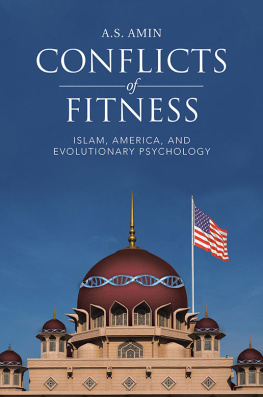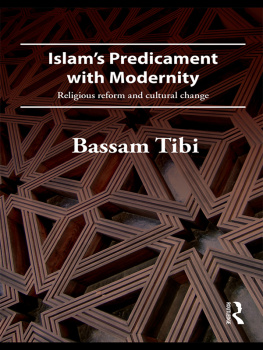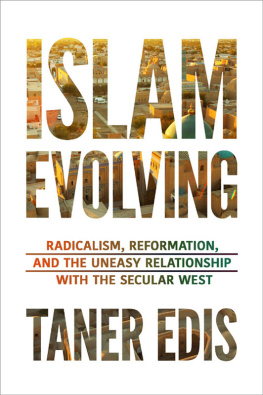CONFLICTS
OF FITNESS
Islam, America, and Evolutionary Psychology
A.S. Amin
Copyright 2015 A.S. Amin.
All rights reserved. No part of this book may be reproduced, stored, or transmitted by any meanswhether auditory, graphic, mechanical, or electronicwithout written permission of both publisher and author, except in the case of brief excerpts used in critical articles and reviews. Unauthorized reproduction of any part of this work is illegal and is punishable by law.
Author photograph: Naveed Khan/ Sunny Images Studios.
ISBN: 978-1-4834-3717-0 (sc)
ISBN: 978-1-4834-3716-3 (e)
Library of Congress Control Number: 2015913917
Because of the dynamic nature of the Internet, any web addresses or links contained in this book may have changed since publication and may no longer be valid. The views expressed in this work are solely those of the author and do not necessarily reflect the views of the publisher, and the publisher hereby disclaims any responsibility for them.
Any people depicted in stock imagery provided by Thinkstock are models, and such images are being used for illustrative purposes only.
Certain stock imagery Thinkstock.
Lulu Publishing Services rev. date: 11/23/2015
CONTENTS
For Mr. Lulu and Gigi
The initial event that ultimately led to the existence of this book took place almost nineteen years ago. I was flipping through TV channels and stumbled upon a show about something called evolutionary psychology on The Learning Channel . It did not take long to realize that this new discipline was capable of offering profound insight into nearly every aspect of human nature.
Over the next several years, I spent an ever-increasing amount of time learning more about evolutionary psychology and analyzing the various aspects of my own life (e.g., my religion, the society in which I lived, the music I listened to, etc.) through this Darwinian framework. I was constantly amazed at the ability of evolutionary psychology to offer elegant, coherent, and parsimonious explanations for what initially appeared to be a bewildering diversity of human beliefs and behaviors. Eventually, I felt I had come up with enough novel arguments to attempt writing a book of my own.
Seven years and countless hours later, my manuscript was complete. After a decade of hard work, all that was left was the trivial matter of getting the book published. Unfortunately, a lack of familiarity with all the publishing options available, along with starting a career and a family, led to a long period of procrastination. Before I knew it, eight more years had passed. However, turning forty has the tendency to refocus a person, and the official passing of my youth has provided me the impetus to finally see this project to its completion.
There is no shortage of books about evolutionary psychology; dozens of excellent books are widely available. So what is special about this one? For starters, the extant literature is largely silent when it comes to Islam. American pop culture, particularly hip-hop, is afforded even less attention. Perhaps this is to be expected; I doubt many evolutionary psychologists have spent a lot of time studying Islamic law or watching Yo! MTV Raps. Yet both Islam and American pop culture, because they occupy opposite ends of the reproductive spectrum (more on this later), bring the logic behind the totality of human reproductive behaviors into sharper focus. Beyond offering a unique perspective on topics routinely covered in other books, this book develops a number of original theories as well. Due to the multidisciplinary nature of this work, it is my strong conviction that anyone with an interest in Islam, evolutionary psychology, or American history and culture will find this book both edifying and engaging.
The long interval between the writing and publishing of this book explains why present-day events are not mentioned; for this shortcoming, I ask the readers indulgence. Nevertheless, I believe that recent events in the Middle East provide stark confirmation of the theories set forth in this book, particularly those found in chapter four.
I would not have been able to write this book without the help of many others, all of whom I owe an enormous debt of gratitude. First of all, I would like to thank my mother and father. Without the education and free time their largesse provided, this book would never have been written. The entirety of the Columbia University library system was an invaluable aid in my research. Dozens of friends offered copious amounts of their limited time to evaluate the manuscript, and their feedback and criticisms improved this book greatly. Lastly, I would like to thank my wife. Inexplicably, she does not agree with everything in this book, particularly the ideas set forth in chapter one. Nonetheless, preparing this book for publication took up a lot of time that otherwise would have been spent with her and the kids, and her (mostly) unflagging support is greatly appreciated.
A.S. Amin
September 2015
The past several decades have witnessed the formation of a revolutionary view of human nature, thanks to developments in the field of evolutionary psychology. Synthesizing evolutionary biology and cognitive psychology,
Although this book will deal with a variety of topics, an underlying theme runs throughout its entirety. Attempts to maximize fitness inevitably cause conflicts of interest to arise. These conflicts manifest themselves in a seemingly endless variety of ways, on levels ranging from the individual to the civilizational. Examining these conflicts of fitness will be the subject of this book.
This book focuses on two civilizations: the Muslim world and the West (particularly the United States). It is our conviction that the study of one often offers insight into the other. Furthermore, the pursuit of maximal fitness involves various compromises and trade-offs, and the different ways these issues are addressed in each civilization has important implications for humanity as a whole.
This book limits itself to certain topics of interest, and does not attempt to discuss the tenets of Islam or evolutionary psychology in a comprehensive manner. Readers may find the books listed in the bibliography useful to remedy this situation.
CHAPTER 1
Polygamy
The origins of this book lie in a discussion I once had with a friend who was sharing her views on religion. It was her opinion that polygyny has no place in a civilized society, deeming it an inherently misogynistic institution set up to cater to the perverted fantasies of men.
Islams allowance of polygyny is just one thing among many that is cited as proof of its misogynistic nature. The first chapter of this book examines polygyny from a biological standpoint. This chapter will also allow us to introduce some of the conceptual foundations for the topics that are discussed in the rest of this book.
* * * * * * * *
A wide range of reproductive strategies can be observed throughout the animal kingdom. For example, reptiles and fish generally produce large quantities of offspring but invest little or no time in raising them, relying on the probability that a small percentage will survive predation and other causes of death and reach maturity. Other animals, including mammals and birds, have fewer offspring but invest a significant amount of time and energy in their upbringing in order to increase the likelihood that they survive.
Focusing on animals that invest heavily in raising their young, different reproductive strategies between the genders are commonly observed. This difference results mainly from differing amounts of parental investment . To begin with, males sex cells are sperm, which can be produced in a nearly limitless supply at almost no cost. Conversely, females sex cells, eggs, are relatively small in number and non-replenishable, making them much more valuable. Furthermore, it is generally the female who must deal with the hardships of gestation, delivery, and oftentimes being the sole provider for her offspring. Contrast this with the male, whose investment is often limited to the sperm he uses to impregnate a female.
Next page











